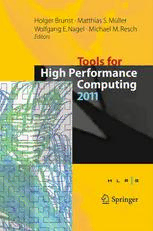Table Of ContentTools for High Performance Computing 2011
•
Holger Brunst Matthias S. Mu¨ller
(cid:2)
Wolfgang E. Nagel Michael M. Resch
(cid:2)
Editors
Tools for High Performance
Computing 2011
Proceedings of the 5th International Workshop
on Parallel Tools for High Performance
Computing, September 2011, ZIH, Dresden
123
Editors MichaelM.Resch
HolgerBrunst Ho¨chstleistungsrechenzentrum
MatthiasS.Mu¨ller Stuttgart(HLRS)
WolfgangE.Nagel Universita¨tStuttgart
Zentrumfu¨rInformationsdienste Nobelstraße19
undHochleistungsrechnen(ZIH) 70569Stuttgart
TechnischeUniversita¨tDresden Germany
01062Dresden
Germany
Frontcoverfigure:MPIcommunicationpatternofa3Dcloudsimulationon512CPUcores
withdynamicloadbalancing.Hilbertspace-fillingcurvesareusedforthedistributionofthe
simulationdata.
ISBN978-3-642-31475-9 ISBN978-3-642-31476-6(eBook)
DOI10.1007/978-3-642-31476-6
SpringerHeidelbergNewYorkDordrechtLondon
LibraryofCongressControlNumber:2012948084
MathematicsSubjectClassification(2010):68-06,68Q85,68Q60,68N19,68U99,94A99,68N99
(cid:2)c Springer-VerlagBerlinHeidelberg2012
Thisworkissubjecttocopyright.AllrightsarereservedbythePublisher,whetherthewholeorpartof
thematerialisconcerned,specificallytherightsoftranslation,reprinting,reuseofillustrations,recitation,
broadcasting,reproductiononmicrofilmsorinanyotherphysicalway,andtransmissionorinformation
storageandretrieval,electronicadaptation,computersoftware,orbysimilarordissimilarmethodology
nowknownorhereafterdeveloped.Exemptedfromthislegalreservationarebriefexcerptsinconnection
with reviews or scholarly analysis or material supplied specifically for the purpose of being entered
and executed on a computer system, for exclusive use by the purchaser of the work. Duplication of
this publication or parts thereof is permitted only under the provisions of the Copyright Law of the
Publisher’slocation,initscurrentversion,andpermissionforusemustalwaysbeobtainedfromSpringer.
PermissionsforusemaybeobtainedthroughRightsLinkattheCopyrightClearanceCenter.Violations
areliabletoprosecutionundertherespectiveCopyrightLaw.
Theuseofgeneraldescriptivenames,registerednames,trademarks,servicemarks,etc.inthispublication
doesnotimply,evenintheabsenceofaspecificstatement,thatsuchnamesareexemptfromtherelevant
protectivelawsandregulationsandthereforefreeforgeneraluse.
While the advice and information in this book are believed to be true and accurate at the date of
publication,neithertheauthorsnortheeditorsnorthepublishercanacceptanylegalresponsibilityfor
anyerrorsoromissionsthatmaybemade.Thepublishermakesnowarranty,expressorimplied,with
respecttothematerialcontainedherein.
Printedonacid-freepaper
SpringerispartofSpringerScience+BusinessMedia(www.springer.com)
Preface
In the pursuit of maintaining exponential growth in the performance of high-
performance computers, the HPC community is currently targeting Exascale sys-
tems. The initial planning for Exascale already started when the first Petaflop
systemwasdelivered.Manychallengesneedtobeaddressedtoreachtherequired
performance level. Scalability, energy efficiency, and fault-tolerance need to be
increased by orders of magnitude.The goal can only be achievedwhen advanced
hardware is combined with a suitable software stack. In fact, the importance of
software is rapidly growing. As a result, many international projects focus on
the necessary software. The International Exascale Software Project (IESP), the
European Exascale Software Initiative (EESI), and the Virtual Institute for High
ProductivitySupercomputing(VI-HPS)areexamples.Theyallsharetheviewthat
toolsareofcomponentsofthesoftwarestack.
The Parallel Tools Workshop that took place in Dresden on September 26–27,
2011, is the fifth in a series of workshops that started in 2007 at the High Per-
formance Computing Center Stuttgart (HLRS). The goal of this series is to bring
together tool developers and users from science and industry in an interactive
environment.Participantsfromresearchanddevelopersfromscience andindustry
wereinvitedtothisinteractiveworkshopwhichattractedscientistsfromalloverthe
world.
Thisyear’spresentationshavebeeninthefieldsofSystemManagement,Parallel
DebuggingandPerformanceAnalysisfromawiderangeofscientificandindustrial
tool developers. This includes tools from vendors such as Allinea, ClusterVision,
Intel,RogueWaveSoftware,andSysFera,aswellasresearchinstitutions,including
Technische Universita¨t Dresden, Universita¨t Erlangen, University of Oregon, and
Rice University. Contribution from research and computer centers came from
Barcelona Supercomputing Center, Research Center Ju¨lich, Karlsruhe Institute
v
vi Preface
of Technology, Lawrence Berkeley National Laboratory, Lawrence Livermore
NationalLaboratory,Pacific NorthwestNationalLaboratory,and the High Perfor-
manceComputingCenterStuttgart.
Dresden,Germany HolgerBrunst
MatthiasS.Mu¨ller
WolfgangE.Nagel
MichaelM.Resch
Contents
1 CreatingaToolSetforOptimizingTopology-Aware
NodeMappings ............................................................. 1
MartinSchulz,AbhinavBhatele,Peer-TimoBremer,Todd
Gamblin,KatherineIsaacs,JoshuaA.Levine,andValerio
Pascucci
1.1 MotivationandBackground ......................................... 1
1.2 GainingInsightfromMultiplePerspectives ........................ 3
1.2.1 TheHACModel............................................ 3
1.2.2 DomainsRelevantforNodeMappings.................... 4
1.2.3 MappingCommunicationtoHardwareData.............. 4
1.3 CreatingaFlexibleMeasurementEnvironment .................... 5
1.3.1 ConcurrentMeasurementsUsingPNMPI................. 5
1.3.2 GatheringDataintheHardwareDomain.................. 6
1.3.3 GatheringDataintheCommunicationDomain........... 6
1.3.4 PhaseAttribution ........................................... 6
1.3.5 DataStorageinStructuredYAMLFiles................... 7
1.3.6 InvestigatingBestCaseMappings......................... 7
1.3.7 ApproximatingCollectives................................. 8
1.4 PreliminaryResults .................................................. 8
1.5 RelatedWork......................................................... 10
1.6 ConclusionsandFutureWork ....................................... 10
References.................................................................... 12
2 UsingSamplingtoUnderstandParallelProgram
Performance................................................................. 13
NathanR.TallentandJohnMellor-Crummey
2.1 Introduction........................................................... 13
2.2 CallPathProfiling.................................................... 15
2.3 PinpointingScalingBottlenecks..................................... 16
vii
viii Contents
2.4 BlameShifting ....................................................... 17
2.4.1 ParallelIdlenessandOverheadinWorkStealing......... 18
2.4.2 LockContention............................................ 19
2.4.3 LoadImbalance............................................. 20
2.5 CallPathTracing..................................................... 21
2.6 Data-CentricPerformanceAnalysis................................. 22
2.7 Conclusions........................................................... 22
References.................................................................... 23
3 likwid-bench: An Extensible Microbenchmarking
Platformforx86MulticoreComputeNodes............................. 27
JanTreibig,GeorgHager,andGerhardWellein
3.1 Introduction........................................................... 27
3.2 RelatedWork......................................................... 28
3.3 Architecture........................................................... 29
3.4 Benchmark.pttFileFormat.......................................... 30
3.5 CommandLineSyntax............................................... 31
3.6 Examples ............................................................. 32
3.6.1 IdentifyingBandwidthBottlenecks........................ 32
3.6.2 CharacterizingccNUMAProperties....................... 33
3.7 ConclusionandOutlook ............................................. 35
References.................................................................... 35
4 AnOpen-SourceTool-ChainforPerformanceAnalysis ............... 37
KevinCoulomb,AugustinDegomme,MathieuFaverge,and
Franc¸oisTrahay
4.1 Introduction........................................................... 38
4.2 RelatedWork......................................................... 38
4.3 InstrumentingApplicationswithEZTRACE ........................ 39
4.3.1 TracingtheExecutionofanApplication.................. 39
4.3.2 InstrumentinganApplication.............................. 40
4.4 CreatingTraceFileswithGTG ..................................... 41
4.4.1 OverviewofGTG .......................................... 41
4.4.2 InteractionBetweenGTGandEZTRACE................. 42
4.5 AnalyzingTraceFileswithVITE ................................... 42
4.5.1 AGenericTraceVisualizer ................................ 43
4.5.2 DisplayingMillionsofEvents ............................. 43
4.6 Evaluation ............................................................ 45
4.6.1 OverheadofTraceCollection.............................. 45
4.6.2 NASParallelBenchmarks.................................. 46
4.7 ConclusionandFutureWork ........................................ 47
References.................................................................... 47
Contents ix
5 DebuggingCUDAAcceleratedParallelApplications
withTotalView.............................................................. 49
ChrisGottbrathandRoydLu¨dtke
5.1 Introduction........................................................... 49
5.1.1 HPCDebuggingChallenges ............................... 50
5.1.2 CUDA and HeterogeneousAcceleration
Architectures................................................ 50
5.1.3 ChallengesIntroducedbyCUDA.......................... 51
5.1.4 TheTotalViewDebugger................................... 52
5.2 TotalViewforCUDA................................................. 53
5.2.1 PreviousExperience:Cell.................................. 53
5.2.2 TheNVIDIAGPUArchitectureandCUDA.............. 54
5.2.3 TheTotalViewModel:ExtendedforCUDA.............. 55
5.2.4 ChallengesandFeatures.................................... 56
6 Advanced Memory Checking Frameworks for MPI
ParallelApplicationsinOpenMPI....................................... 63
ShiqingFan,RainerKeller,andMichaelResch
6.1 Introduction........................................................... 64
6.2 OverviewofDebuggingTools....................................... 65
6.2.1 Valgrind..................................................... 65
6.2.2 IntelPin ..................................................... 66
6.3 DesignandImplementation.......................................... 67
6.3.1 ValgrindExtensions ........................................ 68
6.3.2 MemPin..................................................... 69
6.4 MemoryChecksinParallelApplication ............................ 70
6.4.1 Pre-communicationChecks................................ 70
6.4.2 Post-communicationChecking ............................ 72
6.5 PerformanceImplications............................................ 73
6.6 DetectableErrorClassesandFindingsfromActual
Applications.......................................................... 75
6.7 Conclusion............................................................ 77
References.................................................................... 77
7 Score-P:AJointPerformanceMeasurementRun-Time
InfrastructureforPeriscope,Scalasca,TAU,andVampir ............ 79
AndreasKnu¨pfer,ChristianRo¨ssel,DieteranMey,Scott
Biersdorff,Kai Diethelm,Dominic Eschweiler,Markus
Geimer,MichaelGerndt,DanielLorenz,Allen Malony,
WolfgangE.Nagel,YuryOleynik,PeterPhilippen,Pavel
Saviankou,DirkSchmidl,SameerShende,RonnyTschu¨ter,
MichaelWagner,BertWesarg,andFelixWolf
7.1 Introduction........................................................... 79
7.1.1 MotivationforaJointMeasurementInfrastructure....... 80
7.2 TheSILCandPRIMAProjects...................................... 81
7.3 Score-P................................................................ 83
x Contents
7.4 TheOpenTraceFormatVersion2................................... 84
7.4.1 TheSIONlibOTF2Substrate.............................. 84
7.5 TheCUBE4FormatandGUI........................................ 85
7.6 TheOPARI2InstrumentorforOpenMP ............................ 85
7.7 TheOn-LineAccessInterface....................................... 86
7.8 EarlyEvaluation...................................................... 87
7.8.1 Run-TimeMeasurementOverhead........................ 87
7.8.2 TraceFormatMemoryConsumption...................... 88
7.9 ConclusionandOutlook ............................................. 89
References.................................................................... 90
8 Trace-BasedPerformanceAnalysisforHardwareAccelerators...... 93
GuidoJuckeland
8.1 Introduction........................................................... 93
8.2 RelatedWork......................................................... 94
8.3 GatheringAcceleratorRelatedPerformanceInformation.......... 94
8.3.1 AcceleratorAPIs............................................ 95
8.3.2 TrackingAcceleratorEvents............................... 97
8.3.3 IncludingAcceleratorSpecificData....................... 99
8.4 Example: Integration of CUDA and OpenCL
intoVampirTrace/Vampir............................................ 100
8.5 SummaryandFutureWork .......................................... 103
References.................................................................... 103
9 Folding:DetailedAnalysiswithCoarseSampling...................... 105
HaraldServat,Germa´nLlort,JuditGime´nez,KevinHuck,
andJesu´sLabarta
9.1 Introduction........................................................... 105
9.2 Folding:InstrumentationandSampling............................. 106
9.2.1 TheHardwareCounters.................................... 108
9.2.2 TheCallstack ............................................... 109
9.3 ExampleofUsage.................................................... 110
9.4 ValidationoftheResults............................................. 113
9.5 RelatedWork......................................................... 115
9.6 ConclusionsandFutureDirections.................................. 116
References.................................................................... 117
10 AdvancesintheTAUPerformanceSystem.............................. 119
AllenMalony,SameerShende,WyattSpear,CheeWaiLee,
andScottBiersdorff
10.1 Introduction........................................................... 119
10.2 InstrumentationOfGPUAcceleratedCode......................... 120
10.2.1 SynchronousMethod....................................... 120
10.2.2 EventQueueMethod....................................... 121
10.2.3 CallbackMethod............................................ 122
10.2.4 TAUPerformanceSystemImplementation ............... 122

